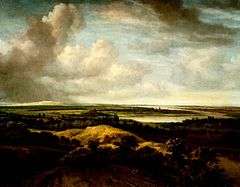Philip de Koninck
Philip de Koninck, or Philips Koninck (5 November 1619 – 4 October 1688 (buried)) was a Dutch landscape painter and younger brother of Jacob Koninck.[1]

De Koninck was born and died in Amsterdam. Little is known of his history except that he was said to be a pupil of Rembrandt, whose influence is to be seen in much of his work. He painted chiefly broad, sunny landscapes, full of space, light and atmosphere; they are seen from a high perspective, allowing a prominent view of the sky. Portraits by him, somewhat in the manner of Rembrandt, also exist (e.g. see Joost van den Vondel); there are examples of these in the galleries at Copenhagen and Oslo. Of his landscapes, the principal are View at the mouth of a river at the Hague, with a slightly larger replica in the National Gallery, London; Woodland border and countryside (with figures by Adriaen van de Velde) at Amsterdam; and landscapes in Brussels, Florence (the Uffizi), Berlin and Cologne. Koninck, a prosperous businessman, appears to have painted few pictures during the last decade of his life.
Several of his works have been falsely attributed to Rembrandt and many more to his nephew Salomon de Koninck (1609–1656), also a disciple of Rembrandt, whose paintings and etchings consist mainly of portraits and biblical scenes. He was also the uncle of the painters Jacob II and Daniel Koninck.
All of these painters are to be distinguished from David Koninck (1636?-1687), also known as Rammelaar. David Koninck was born in Antwerp and studied there under Jan Fyt. He later settled in Rome, where he is stated to have died in 1687; this, however, is doubtful. His pictures are chiefly landscapes with animals and still life.
| Wikimedia Commons has media related to Philips Koninck. |
References
- ↑ Philips Koninck in the RKD
 This article incorporates text from a publication now in the public domain: Chisholm, Hugh, ed. (1911). "article name needed". Encyclopædia Britannica (11th ed.). Cambridge University Press. The article is available here.
This article incorporates text from a publication now in the public domain: Chisholm, Hugh, ed. (1911). "article name needed". Encyclopædia Britannica (11th ed.). Cambridge University Press. The article is available here.
External links
- Philip de Koninck at PubHist